When Will Canon Bring 4k To Mainstream Cameras
Canon has launched its first EOS R APS-C ingather sensor cameras, the 32-megapixel EOS R7 and 24-megapixel EOS R10. The new models bring Canon's APS-C and full-frame RF series in alignment, so yous can finally use lenses interchangeably, much as you lot can with its EF and EF-S DSLR cameras. More importantly, they deport impressive specs like xv fps mechanical shutter shooting speeds, 4K video at upward to 60fps and Canon's impressive Dual Pixel autofocus. Both are reasonably priced, every bit well.
Canon EOS R7
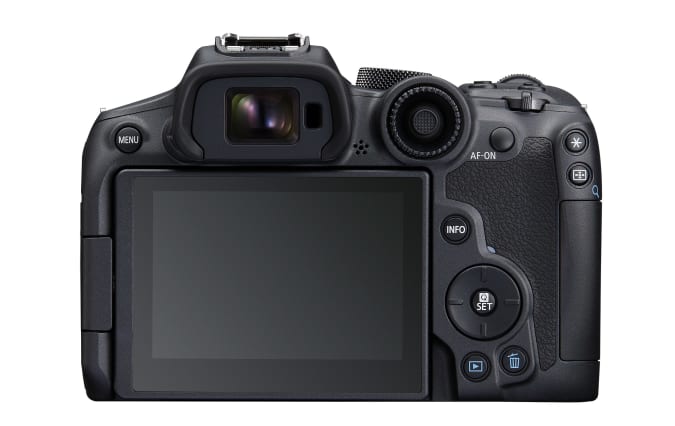
Canon
The R7 is the higher-end selection and has an all-new body with some blueprint features nosotros've not seen on any camera earlier. Rather than the typical ii dials on top and one on dorsum, information technology has just ii. The 2nd dial sits on back only at the top, wrapping around the focus point joystick. Information technology looks like it could work, merely Canon has had mixed success when messing with its camera layouts — the touch bar on the EOS R was not a popular feature, for instance.
It has a decent sized grip and weighs in at 612 grams (21.vi ounces), quite a fleck more Sony'southward 503 gram A6600. Vloggers get a fully articulating 3-inch 1.62 million dot brandish and a 2.36-million dot OLED EVF, which is sub-par compared to the 3.69 one thousand thousand dot EVF on Fujifilm's rival Ten-T4. The R7 offers 5-axis in-torso stabilization rated up to 7 stops, the best in its category. Other key features include dual UHS-Two card slots and both microphone and headphone ports. It uses the same LP-E6NH batteries as the R6 and R5, with Catechism promising an first-class 660 shots per accuse with the EVF enabled.
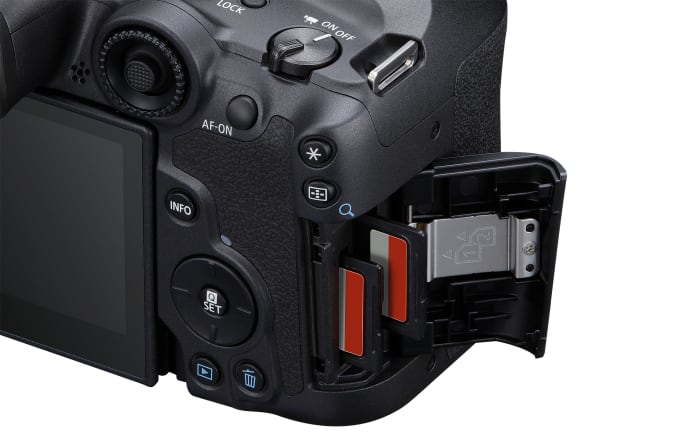
Canon
The R7 has a 32-megapixel sensor that'southward neither stacked nor backside illuminated. Nevertheless, it is new and non the same equally found on other Canon APS-C cameras like the M6 Mark II. Much like that model, information technology allows for some seriously fast shooting, with 30 fps in electronic shutter mode and a superb fifteen fps in mechanical shutter fashion — all with continuous autofocus and machine-exposure enabled. You can capture compressed RAW photos for well-nigh six seconds (100 shots) earlier the buffer fills in mechanical shutter mode, or 65 shots at xxx fps in electronic mode.
Autofocus is powered by Catechism's fantabulous Dual Pixel system for both photos and videos. Canon says information technology inherited the system from its flagship R3, including the new bailiwick-, eye- and face-tracking features (it doesn't accept the center-tracking Eye AF option, though). That means y'all should see AF performance on par with what Sony offers and superior to Nikon and Fujifilm's systems.
As for video, you tin shoot 4K at upwards to 30p using the full 7K sensor surface area, which should allow for extremely sharp video, though recording time is limited to xxx minutes due to thermal limits. It can also handle sub-sampled (line-skipped) 4K at 60 fps, or do the same with a considerable 1.81x crop, with no overheating time issues. Information technology tin can shoot 1080p at up to 120 fps.
You can shoot HDR PQ video if y'all desire to create HDR content, or capture 10-flake footage in the C-Log 3 profile for extra editing and color correction flexibility. That feature, combined with the flip-out display, in-body stabilization and 4K modes, makes the R7 is 1 of the most capable APS-C cameras out there for video or vlogging.
Canon EOS R10
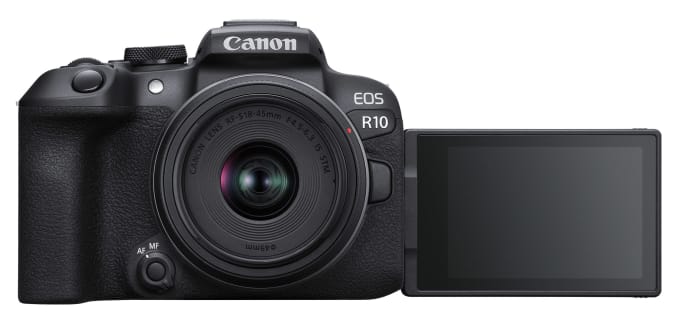
Catechism
The EOS R10 dials the characteristic set dorsum a bit from the R7, but information technology's nonetheless a very capable mirrorless photographic camera. The biggest difference is in the resolution, with the R10 offering 24 megapixels rather than 32. It as well lacks in-body stabilization, so you'll need to rely on stabilized lenses for that. And while it has a flip-out display like the R7, the resolution is lower at 1.04 million dots (the 2.36 million dot OLED EVF is the same).
As with the R7, it tin shoot continuous bursts at up to 15 fps with the mechanical shutter, or 23 fps in silent electronic mode. Yet, the buffer will fill quicker, allowing for merely almost 30 shots in mechanical fashion or about 26 shots in silent mode.
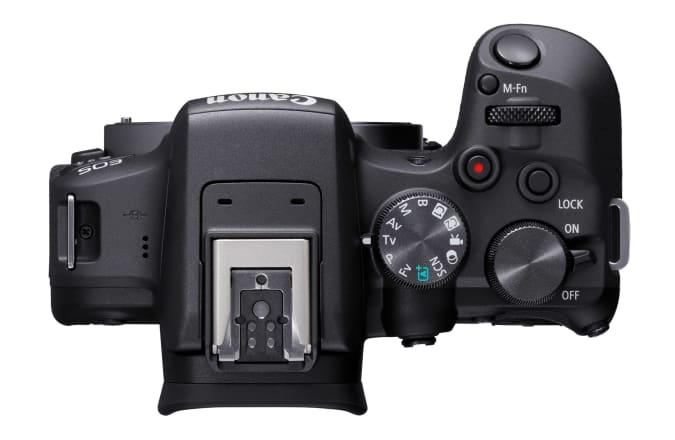
Catechism
The body design is unlike, with a more than typical two-punch layout on top. It's considerably smaller than the R7, weighing simply 426 grams (15 ounces). The grip is slightly smaller, and there's less infinite for your hand betwixt the grip and lens.
On the video side, yous're not giving up too much. It can as well shoot oversampled 4K video at 30fps using the full sensor width, or 4K 60p video with a one.56x crop. It can capture ten-bit video in HDR PQ manner, merely doesn't offer whatever log settings. It comes with a microphone port, just no headphone jack.
Pricing, lenses, availability
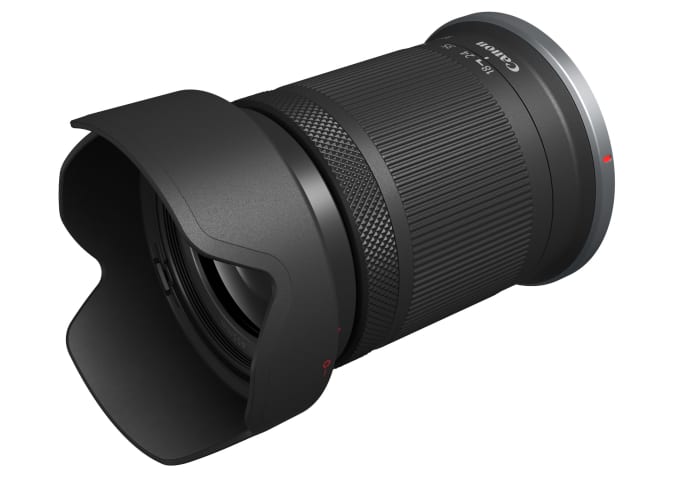
Canon
By using the superior RF mount, the new cameras brand Canon's lineup less confusing and should help it better compete against APS-C models from Nikon and Sony. However, it begs the question of what information technology plans to practise with its current EF-M APS-C mirrorless cameras. Given the more versatile and futurity-proof EOS R system, information technology's hard to imagine that it'll continue both around.
Canon launched its kickoff RF-S lenses along with the new cameras, optimized for the smaller APS-C sensor sizes. They're entry-level kit-style lenses that won't exactly set the camera world on fire, just you can apply RF total-frame lenses and even EF lenses with an adapter. The two new models are the $300 RF-S18-45mm f/four.5-half dozen.3 IS STM and $500 RF-S18-150mm IS STM, with a 35mm field of view of 29-72mm and 29-240mm, respectively. Both tin be used on full-frame EOS R models, admitting with a one.5x crop.
The EOS R10 volition cost $980 for the torso only, or $1,100 with the RF-S18-45mm lens and $1,380 with the RF-S18-150mm lens. The R7, meanwhile, will sell for $1,500 for the torso only, or $1,900 with the S18-150mm lens. Both cameras and the lenses will go far in belatedly 2022.
All products recommended by Engadget are selected by our editorial team, independent of our parent company. Some of our stories include chapter links. If y'all buy something through one of these links, we may earn an affiliate commission.
Source: https://www.engadget.com/canon-eos-r-7-and-eos-r-10-rf-mount-crop-sensor-cameras-090900429.html
Posted by: nelsoncovelf.blogspot.com

0 Response to "When Will Canon Bring 4k To Mainstream Cameras"
Post a Comment